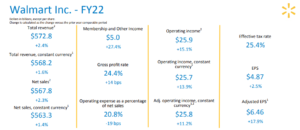Updated on February 6th, 2023 by Samuel Smith
The Dividend Aristocrats are a select group of 68 companies in the S&P 500 Index, with 25+ consecutive years of dividend increases. We believe the Dividend Aristocrats are among the best dividend stocks to buy-and-hold for the long term.
Retail heavyweight Walmart Inc. (WMT) is one of the better-known Dividend Aristocrats. It is widely recognized, not just for its strong brand and industry dominance, but also for its long dividend history.
You can see a full downloadable spreadsheet of all 68 Dividend Aristocrats, along with several important financial metrics such as price-to-earnings ratios and dividend yields, by clicking on the link below:
Walmart’s first dividend was $0.05 per share, paid in 1974. It has increased its dividend each year since, and now pays a quarterly dividend of $0.56 per share. Walmart has increased its dividend for 49 consecutive years, putting it on the verge of becoming a Dividend King.
Recent years have been difficult for many retailers. The threat of Internet retail competition, led by Amazon (AMZN), as well as the impact of the coronavirus pandemic over the last two years, has had a negative impact on many retailers.
However, Walmart has fared very well in recent years by adapting to the changing environment. It has invested heavily in its own e-commerce platform, and the stock has generated strong returns for shareholders. Walmart, as opposed to many other retailers, has proven it is one of the best-equipped to compete with Amazon.
Business Overview
The first Walmart store opened in 1962 in Rogers, Arkansas. It was founded by Sam Walton, who started the business with a simple vision: to offer the lowest prices. This philosophy led to Walmart’s huge growth over the years. Walmart went public in 1972. At that time, it had 51 stores, and annual sales of $78 million.
Today, Walmart generates annual sales of more than $572.7 billion. It operates more than 10,000 stores, that serve nearly 230 million customers worldwide each week.
Source: Investor Presentation
Walmart has also expanded into a variety of different services, making it a true conglomerate. The Walmart U.S. segment includes retail stores in all 50 U.S. states, Washington D.C., and Puerto Rico. It also includes Walmart’s digital business. Walmart International consists of operations in 25 countries outside of the U.S.
Lastly, Sam’s Club consists of membership-only warehouse clubs and operates in 48 states in the U.S. and in Puerto Rico.
Growth Prospects
Walmart reported third quarter earnings on November 15th, 2022, and results were better than expected on both the top and bottom lines by wide margins. Adjusted earnings-per-share came to $1.50, which was 18 cents better than expected. In addition, revenue was up 8.8% from the comparable period a year ago, reaching $153 billion, and beating estimates by $6 billion. On a constant currency basis, revenue was up 9.8%. Comparable sales in the US were up 8.2%, easily beating consensus of +6.9%. On a two-year stack basis, comparable sales were up 17.4%. Transactions during the quarter were up 2.1%, while average ticket was up 6.0%. At Sam’s Club, comparable sales were 10% higher, as transaction growth was up 4.8%.
Walmart International saw total sales rise 7.1%. Consolidated gross profit was down 89bps, which was primarily due to markdowns and the mix of sales in the US, as well as an inflation-related charge at Sam’s Club. Adjusted operating expenses as a percentage of sales declined 75bps, which was due to sales leverage and lower COVID-related costs. The company announced a new $20 billion share repurchase plan. We now see $6.10 in earnings-per-share for this year.
Source: Investor Presentation
We currently forecast Walmart to grow its earnings-per-share by 8% per year over the next five years.
Competitive Advantages & Recession Performance
Walmart’s main competitive advantage is its massive scale. Its distribution efficiencies allow Walmart to keep transportation costs low. It can pass on these savings to customers through everyday low prices.
Walmart retains its brand strength through advertising. Because of its immense financial resources, Walmart can afford to spend billions each year on advertising.
Walmart’s competitive advantage also provides the company with steady profitability. This is true, even during recessions. The company performed phenomenally well during the Great Recession.
It steadily grew earnings-per-share each year in that time.
- 2007 earnings-per-share of $3.16
- 2008 earnings-per-share of $3.42 (8.2% increase)
- 2009 earnings-per-share of $3.66 (7% increase)
- 2010 earnings-per-share of $4.07 (11% increase)
This was a very impressive performance, in one of the worst recessions in decades. The company continued to generate strong results last year, when the U.S. economy entered recession due to the coronavirus pandemic.
Walmart’s growth indicates the company might actually benefit from recessions. As the low-cost leader in retail, Walmart conceivably sees higher traffic during economic downturns, when consumers scale down from higher-priced retailers.
Valuation & Expected Returns
Walmart shares currently trade at a price of ~$140. Using our earnings-per-share estimate of $6.10 for the current fiscal year, the stock has a price-to-earnings ratio of 23x. This is well above the stock’s historical valuation. The current valuation is at a 10-year high.
We currently view a P/E ratio of 21 as fair value for Walmart stock. Investors should also note that retailers have typically not held P/E multiples above 20. If the valuation multiple were to revert to our fair value estimate by fiscal 2027, the company’s total returns would face a 180 basis point annualized headwind over this period of time.
Walmart shares have performed very well for an extended period. While this has rewarded shareholders with strong returns, we view Walmart as a slightly overvalued stock right now.
Aside from changes in the P/E multiple, Walmart should also generate returns from earnings growth and dividends. A projection of expected returns is below:
- 8.0% earnings-per-share growth
- 1.6% dividend yield
- -1.8% multiple reversion
In this scenario, Walmart is projected to generate a total return of just 7.8% per year over the next five years.
Final Thoughts
While many retailers have struggled with adapting to the change in commerce shopping habits, Walmart has made the proper strategic investments in our view. The company’s impressive e-commerce growth is reflective of this view.
The company has performed well and the stock has outperformed the S&P 500 Index in the past five years. We find the company’s dividend track record to be impressive, even if the most recent dividend hikes were on the small side.
Walmart is a safe, defensive stock in times of economic hardship, but the rich valuation prevents it from being a Buy today. As a result, we rate it a Hold.
If you are interested in finding more high-quality dividend growth stocks suitable for long-term investment, the following Sure Dividend databases will be useful:
- The 20 Highest Yielding Dividend Aristocrats
- The Dividend Kings List is even more exclusive than the Dividend Aristocrats. It is comprised of 40 stocks with 50+ years of consecutive dividend increases.
- The 20 Highest Yielding Dividend Kings
- The Dividend Achievers List: a group of stocks with 10+ years of consecutive dividend increases.
- The Dividend Champions List: stocks that have increased their dividends for 25+ consecutive years.
Note: Not all Dividend Champions are Dividend Aristocrats because Dividend Aristocrats have additional requirements like being in The S&P 500. - The Dividend Contenders List: 10-24 consecutive years of dividend increases.
- The Dividend Challengers List: 5-9 consecutive years of dividend increases.
- The Monthly Dividend Stocks List: contains stocks that pay dividends each month, for 12 payments per year.
- The 20 Highest Yielding Monthly Dividend Stocks
- The High Dividend Stocks List: high dividend stocks are suited for investors that need income now (as opposed to growth later) by listing stocks with 5%+ dividend yields.
The major domestic stock market indices are another solid resource for finding investment ideas. Sure Dividend compiles the following stock market databases and updates them monthly:


